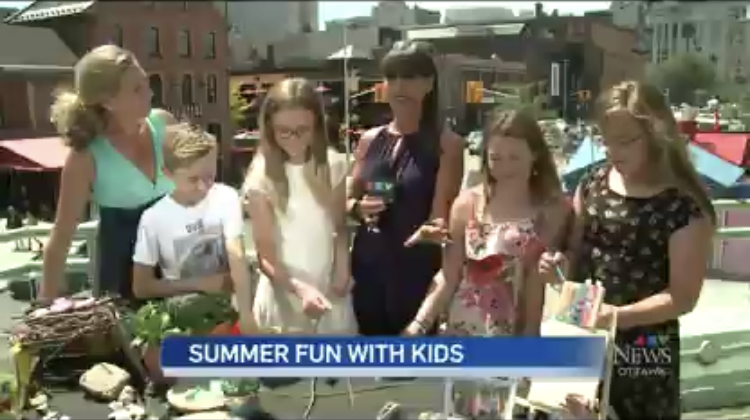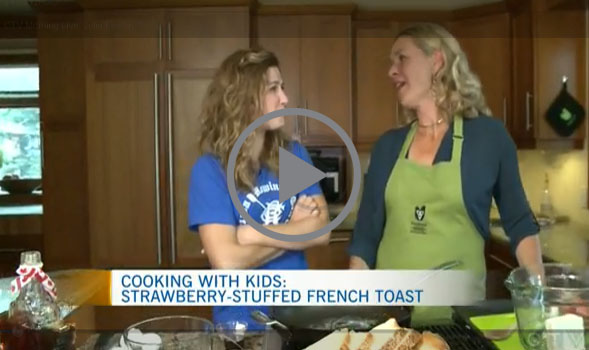
The kids have been back to school for a few weeks now and I have been getting a few requests for tennis balls, marbles, chalk and skipping ropes for school yard play. I am so happy to fill the kid's backpacks with these essentials to keep them active during recess and I love that the kids enjoy some of the same games that I did when I was young. Play is an essential part of the development of all children and traditional playground games have been played for many years. These types of games are also great ice breakers to making new friends and getting to know the kids on the playground.
*Parent Tip: Check in with your school's parent council. These groups of organized parents often take the lead in supporting student and teacher's needs. This year, I worked with the council at my children's school as we painted the playground for hopscotch, foursquare and a few other templates to get the fun started.

Marbles
What you need: two or more players, chalk (or a stick), marbles
How to play: Draw a circle, about 1 m across, on asphalt with chalk (if you’re playing on sand, use a stick). Scatter a few marbles from each player into the ring. Have each player select a “shooter” marble that looks different from the others (and is preferably larger). Taking turns, shoot your marble from just outside the circle. Kneel on the ground cradling the shooter in the crook of your index finger, and flick the marble with your thumb. The goal is to bump the other marbles out of the circle. If you’re successful, go again and collect the marbles you’ve knocked out. Remove your shooter at the end of your turn. When the ring is empty, count your marbles; the player with the most marbles is the winner.
Fair-play tip: Decide at the outset if you are playing for keeps or if you will return the marbles to the original owners.
Four-square
What you need: four players, chalk, bouncy ball
How to play: Draw a large square (about 2 x 2 m) on asphalt. Divide it into four equal squares numbered one to four. One player stands in each square. The player in square four starts by bouncing the ball once in her own square, then sends it to another player in one bounce. If the ball lands outside of the intended square or doesn’t bounce before it reaches the intended player, the sender goes to square one and all the other players go up a square. If the intended player doesn’t catch the ball, she goes back to square one. If she does catch it, she then bounces it to another player, and so on. Each round always starts at square four. The player who spends the most time in square four wins.
Fair-play tip: Who should start in square four? Try going alphabetically by first name.
Wall Ball
What you need: one wall, one ball that bounces well, two or more players
How to play: The basic activity of the game is throwing the ball up against the wall, letting it bounce on the ground if you want, then catching it. You can throw it against the wall and catch it yourself, or let another team member catch it.
The fun starts when a person throws the ball and it touches the ground before hitting the wall or a person fumbles or drops the ball in any way. When either of these things happen, the fumbler/bad thrower must run to the wall. Meanwhile another player is trying to throw the ball so that it hits the wall before the fumbler can touch the wall. If the fumbler can make it to the wall first, game play continues. If the ball gets there first, the fumbler has one strike, then game play continues.
Fair-play tip: Establish out of bounds areas for height of the throw.
7-UP
What you need: one wall, one ball that bounces well, one or more players
How to play: The object of the game is to bounce the ball against the wall a set number of times while performing a skill in between bounces. The skills are as follows (but your memory may vary!):
Sevensies: Bounce the ball against the wall seven times. Catch it on the seventh time.
No-wall version: Bounce the ball against the ground seven times.
Sixies: Bounce the ball against the wall and then allow it to bounce once on the ground before you catch it and throw it again. Repeat six times.
No-wall version: Throw the ball up in the air 6 times (no bounces).
Fivesies: Bounce the ball on the ground five times.
No-wall version: Bounce the ball on the ground 5 times, but throw it hard enough so it bounces up over your head. Catch on the way down.
Foursies: Bounce the ball from the ground to the wall and then back to you (this is the opposite of what you do for Sixies). Repeat four times.
No-wall version: Throw the ball up, let bounce, then catch. Repeat 4 times.
Threesies: Bounce the ball on the ground first, then use your palm to bat the ball against the wall, then catch it before it bounces on the floor again. Repeat three times.
No-wall version: Bounce the ball, then hit it down again before catching. Repeat 3 times.
Twosies: Toss the ball under your leg and bounce off the wall, then catch. Repeat.
No-wall version: Bounce the ball under your leg, twice.
Onesies: Throw the ball against the wall, spin around completely (360 degrees), then catch the ball before it bounces. No-wall version: Throw the ball up in the air, do your spin while it falls and bounces, then catch. The game concludes when the players have completed each of the levels.

Hopscotch
Hopscotch is a wonderful hopping game that can be played on a bare patch of ground or on a floor
indoors. There are hundreds of variations of the diagram that can be drawn. Use your favorite
version to have children play.
What you need: flat surface, chalk or stick, marker (stone, beanbag, bottlecap, shell, button)
How to play: Draw a hopscotch pattern on the ground or use masking tape on a floor. Create a
diagram with 8 sections and number them. The first player stands behind the starting line to toss her or his marker in square 1. Hop over square 1 to square 2 and then continue hopping to square 8, turn around, and hop back again. Pause in square 2 to pick up the marker, hop in square 1, and out. Then continue by tossing the stone in square 2. All hopping is done on one foot unless the hopscotch design is such that two squares are side-by-side. Then two feet can be placed down with one in each square. A player must always hop over any square where a maker has been placed.
A player is out if the marker fails to land in the proper square, the hopper steps on a line, the
hopper looses balance when bending over to pick up the marker and puts a second hand or foot
down, the hopper goes into a square where a marker is, or if a player puts two feet down in a
single box. The player puts the marker in the square where he or she will resume playing on the
next turn, and the next player begins.
Man Hunt
What you need to play: people, a large area, a timer
How to play the game: One person is designated as the "Hunter." The remaining players are called convicts To begin play, the Hunter gives all of the players 5 minutes to run and find a spot to hide. During this time, the Hunter cannot see where the others are headed. The Hunter must remain stationary and can make no attempt to track any convicts before the 5 minutes are up. Once the 5 minutes are up, the Hunter enters the field of play and tries to capture the convicts as quickly as possible. Catching is simple. All the Hunter needs to do is touch one of the escaped convicts. Once a convict is caught he/she is now on the side of the hunter. Convicts are instantly turned into hunters and can now catch other convicts.Any convicts not caught after 30 minutes from the Hunter beginning his/her hunt are considered escaped and free. They have eluded the Hunter and have won the game. If all of the convicts be caught, the hunters win.
Fair-play tip: Make sure you clearly define any out-of-bounds areas, players cannot leave the field of play.
Skipping Games
I remember endless hours of playground skipping with my friends. We take turns holding the rope and play single or double dutch. We shared sings songs and practiced our skills together until the recess bell rang and then went back to class with these songs in our heads until lunch hour break.
Teddy bear, teddy bear, turn around
Teddy bear, teddy bear, touch the ground.
Teddy bear, teddy bear, show your shoe.
Teddy bear, teddy, bear, that will do.
Teddy bear, teddy bear, go upstairs
Teddy bear, teddy bear, say your prayers
Teddy bear, teddy bear, turn out the light
Teddy bear, teddy, bear, say goodnight.
I had a little puppy,
His name was Tiny Tim,
I put him in the bathtub, to see if he could swim,
He drank all the water, he ate a bar of soap,
The next thing you know he had a bubble in his throat.
In came the doctor, (person jumps in)
In came the nurse, (person jumps in)
In came the lady with the alligator purse (person jumps in)
Out went the doctor (person jumps out)
Out went the nurse (person jumps out)
Out went the lady with the alligator purse (person jumps out).
Girl guide, girl guide, dressed in blue,
These are the actions you must do:
Stand at attention, stand at ease,
Bend your elbows, bend your knees.
Salute to the captain, bow to the Queen,
Turn your back on the dirty submarine.
I can do the heel and toe, I can do the splits.
I can do the hootchy-kootchy, just like this.
Clapping Games

The Cup Song from the movie Pitch Perfect caught on like wildfire around here. The clapping game is very cute, the song that goes with it; however is not terribly very age appropriate (whisky is involved). Either way, most girls know how to do all of the actions these days. Here is a link to the original video.
http://www.youtube.com/watch?v=cmSbXsFE3l8
I love these other easy clapping rhymes.
https://www.youtube.com/watch?v=hyhL2Wdjpbc
Cat’s Cradle
 Cat’s cradle is a classic school yard game. I played it, my mother played it and am I sure my Grandmother could show us how to play as well. There are a number of variations on the game and on the set up so, the best way to learn is to watch a video or have someone else show you.
Cat’s cradle is a classic school yard game. I played it, my mother played it and am I sure my Grandmother could show us how to play as well. There are a number of variations on the game and on the set up so, the best way to learn is to watch a video or have someone else show you.
 Tuesday, October 1, 2013 at 11:54AM
Tuesday, October 1, 2013 at 11:54AM  Call it what you want, if you and your family love the easy dinner of fresh local eggs, it is time to whip them into some hearty new suppertime recipes. Eggs are excellent anytime and what’s more is that these recipes make it easy for everyone in the family to get involved in meal prep.
Call it what you want, if you and your family love the easy dinner of fresh local eggs, it is time to whip them into some hearty new suppertime recipes. Eggs are excellent anytime and what’s more is that these recipes make it easy for everyone in the family to get involved in meal prep. 











































































